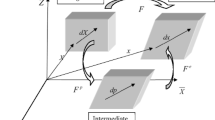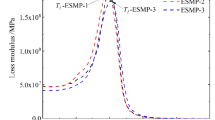Abstract
A series of monotonic tensile experiments of thermo-induced shape memory polyurethane (TSMPU) at different loading rates were carried out to investigate the interaction between the internal heat production and the mechanical deformation. It is shown that the temperature variation on the surfaces of the specimens due to the internal heat production affects the mechanical properties of TSMPU remarkably. Then, based on irreversible thermodynamics, the Helmholtz free energy was decomposed into three parts, i.e., the instantaneous elastic free energy, visco-plastic free energy and heat free energy. The total deformation gradient was decomposed into the mechanical and thermal parts, and the mechanical deformation gradient was further divided into the elastic and visco-plastic components. The Hencky’s logarithmic strain was used in the current configuration. The heat equilibrium equation of internal heat production and heat exchange was derived in accordance with the first and second thermodynamics laws. The temperature of specimens was contributed by the internal heat production and the ambient temperature simultaneously, and a thermo-mechanically coupled thermo-elasto-visco-plastic model was established. The effect of temperature variation of specimens on the mechanical properties of the material was considered in this work. Finally, the capability of the proposed model was validated by comparing the simulated results with the corresponding experimental data of TSMPU.
















Similar content being viewed by others
Change history
22 November 2018
In all the articles in Acta Mechanica Solida Sinica, Volume 31, Issues 1–4, the copyright is incorrectly displayed as “The Chinese Society of Theoretical and Applied Mechanics and Technology ” where it should be “The Chinese Society of Theoretical and Applied Mechanics”.
References
Lendlein A, Kelch S. Shape-memory polymers. Angew Chem Int Ed. 2002;41(12):2035–57.
Leng JS, Lan X, Liu YJ, Du SY. Shape-memory polymers and their composites: stimulus methods and applications. Prog Mater Sci. 2011;56(7):1077–135.
Hu JL, Zhu Y, Huang H, Lu J. Recent advances in shape-memory polymers: structure, mechanism, functionality, modeling and applications. Prog Polym Sci. 2012;37(12):1720–63.
Huang WM, Zhao Y, Wang CC, Ding Z, Purnawali H, Tang C. Thermo/chemo-responsive shape memory effect in polymers: a sketch of working mechanisms, fundamentals and optimization. J Polym Res. 2012;19(9):9952.
Liu YJ, Lv HB, Lan X, Leng JS, Du SY. Review of electro-active shape-memory polymer composite. Compos Sci Technol. 2009;69(13):2064–8.
Yakacki CM, Satarkar NS, Gall K, Likos R, Hilt JZ. Shape-memory polymer networks with \({\text{ Fe }_{3}}{\text{ O }_{4}}\) nanoparticles for remote activation. J Appl Polym Sci. 2009;112(5):3166–76.
Leng JS, Wu X, Liu YJ. Infrared light-active shape memory polymer filled with nanocarbon particles. J Appl Polym Sci. 2010;114(4):2455–60.
Lendlein A, Jiang H, Jünger O, Langer R. Light-induced shape-memory polymers. Nature. 2005;434(7035):879–82.
Zhu Y, Hu J, Luo H, Young RJ, Deng L, Zhang S. Rapidly switchable water-sensitive shape-memory cellulose/elastomer nano-composites. Soft Matter. 2012;8(8):2509–17.
Lu HB, Huang WM, Leng JS. On the origin of Gaussian network theory in the thermo/chemo-responsive shape memory effect of amorphous polymers undergoing photo-elastic transition. Smart Mater Struct. 2016;25(6):065004.
Lu HB, Huang WM, Leng JS. Quantitative separation of the influence of copper (II) chloride mass migration on the chemo-responsive shape memory effect in polyurethane shape memory polymer. Smart Mater Struct. 2016;25(10):105003.
Yakacki CM, Shandas R, Lanning C, Rech B, Eckstein A, Gall K. Unconstrained recovery characterization of shape-memory polymer networks for cardiovascular applications. Biomaterials. 2007;28(14):2255–63.
Yang Q, Fan J, Li GQ. Artificial muscles made of chiral two-way shape memory polymer fibers. Appl Phys Lett. 2016;109(18):183701.
Flanagan JS, Strutzenberg RC, Myers RB, Rodrian JE. Development and flight testing of a morphing aircraft, the NextGen MFX-1. In: Proceedings of the 48th AIAA. ASME/ASCE/AHS/ASC Structures, Structural Dynamics and Materials Conference [2007 Apr]; 23–26. Honolulu, Hawaii, USA). AIAA.
Lan X, Liu Y, Lv HB, Wang X, Leng JS, Du SY. Fiber reinforced shape-memory polymer composite and its application in deployable hinge in space. Smart Mater Struct. 2009;18(2):024002.
Hu JL, Ding XM, Tao XM, Yu JM. Shape memory polymers and their applications to smart textile products. J Donghua Univ Engl version. 2002;19(3):89–93.
Mondal S, Hu JL. Temperature stimulating shape memory polyurethane for smart clothing. Indian J Fibre Text Res. 2006;31(1):66–71.
Wu X, Huang WM, Zhao Y, Ding Z, Tang C, Zhang J. Mechanisms of the shape memory effect in polymeric materials. Polymers. 2013;5(4):1169–202.
Li GQ, Xu W. Thermomechanical behavior of thermoset shape memory polymer programmed by cold-compression: testing and constitutive modeling. J Mech Phys Solids. 2011;59(6):1231–50.
Kim BK, Sang YL, Mao X. Polyurethanes having shape memory effects. Polymer. 1996;37(26):5781–93.
Tobushi H, Hara H, Yamada E, Hayashi S. Thermomechanical properties in a thin film of shape memory polymer of polyurethane series. Smart Mater Struct. 1996;5(4):483–91.
Tobushi H, Hashimoto T, Hayashi S, Yamada E. Thermomechanical constitutive modeling in shape memory polymer of polyurethane series. J Intell Mater Syst Struct. 1997;8(8):711–8.
Qi HJ, Nguyen TD, Castro F, Yakacki CM, Shandas R. Finite deformation thermo-mechanical behavior of thermally induced shape memory polymers. J Mech Phys Solids. 2008;56(5):1730–51.
Ji FL. Study on the shape memory mechanism of SMPUs and development of high-performance SMPUs. Hung Hom: Hong Kong Polytechnic University; 2010.
Kim JH, Kang TJ, Yu WR. Thermo-mechanical constitutive modeling of shape memory polyurethanes using a phenomenological approach. Int J Plast. 2010;26(2):204–18.
Arrieta S, Diani J, Gilormini P. Experimental characterization and thermoviscoelastic modeling of strain and stress recoveries of an amorphous polymer network. Mech Mater. 2014;68(1):95–103.
Du H, Liu L, Zhang F, Zhao W, Leng J, Liu Y. Thermal-mechanical behavior of styrene-based shape memory polymer tubes. Polym Test. 2017;57:119–25.
Pieczyska EA, Staszczak M, Kowalczyk-Gajewska K, Maj M, Golasiński K, Golba S, Tobushi H, Hayashi S. Experimental and numerical investigation of yielding phenomena in a shape memory polymer subjected to cyclic tension at various strain rates. Polym Test. 2017;60:333–42.
Pieczyska EA, Staszczak M, Maj M, Kowalczyk-Gajewska K, Golasiński K, Cristea M, Tobushi H, Hayashi S. Investigation of thermomechanical couplings, strain localization and shape memory properties in a shape memory polymer subjected to loading at various strain rates. Smart Mater Struct. 2016;25(8):085002.
Pieczyska EA, Maj M, Kowalczyk-Gajewska K, Staszczak M, Urbanski L, Tobushi H, Hayashi S. Mechanical and infrared thermography analysis of shape memory polyurethane. J Mater Eng Perform. 2014;23(7):2553–60.
Pieczyska EA, Maj M, Kowalczyk-Gajewska K, Staszczak M, Gradys A, Majewski M, Tobushi H, Hayashi S. Thermomechanical properties of polyurethane shape memory polymer—experiment and modelling. Smart Mater Struct. 2015;24(4):045043.
Thomson W. II. On the thermoelastic, thermomagnetic, and pyroelectric properties of matter. Lond Edinb Dublin Philos Mag J Sci. 1851;5(28):4–27.
Pieczyska EA. Thermoelastic effect in austenitic steel referred to its hardening. J Theor Appl Mech. 1999;37(2):349–68.
Moreau S, Chrysochoos A, Muracciole JM, Wattrisse B. Analysis of thermoelastic effects accompanying the deformation of PMMA and PC polymers. Comptes Rendus Mécanique. 2005;333(8):648–53.
Ames NM, Srivastava V, Chester SA, Anand L. A thermo-mechanically coupled theory for large deformations of amorphous polymers. Part II: applications. Int J Plast. 2009;25(8):1495–539.
Srivastava V, Chester SA, Ames NM, Anand L. A thermo-mechanically-coupled large-deformation theory for amorphous polymers in a temperature range which spans their glass transition. Int J Plast. 2010;26(8):1138–82.
Anand L, Ames NM, Srivastava V, Chester SA. A thermo-mechanically coupled theory for large deformations of amorphous polymers. Part I: formulation. Int J Plast. 2009;25(8):1474–94.
Billon N. New constitutive modeling for time-dependent mechanical behavior of polymers close to glass transition: fundamentals and experimental validation. J Appl Polym Sci. 2012;125(6):4390–401.
Maurel-Pantel A, Baquet E, Bikard J, Bouvard JL, Billon N. A thermo- mechanical large deformation constitutive model for polymers based on material network description: application to a semi-crystalline polyamide 66. Int J Plast. 2015;67:102–26.
Pouriayevali H, Arabnejad S, Guo YB, Shim VPW. A constitutive description of the rate-sensitive response of semi-crystalline polymers. Int J Impact Eng. 2013;62:35–47.
Yu C, Kang GZ, Chen KJ, Lu FC. A thermo-mechanically coupled nonlinear viscoelastic–viscoplastic cyclic constitutive model for polymeric materials. Mech Mater. 2016;105:1–15.
Yu C, Kang GZ, Chen KJ. A hygro-thermo-mechanical coupled cyclic constitutive model for polymers with considering glass transition. Int J Plast. 2017;89:29–65.
Nguyen TD, Qi HJ, Castro F, Long KN. A thermoviscoelastic model for amorphous shape memory polymers: incorporating structural and stress relaxation. J Mech Phys Solids. 2008;56(9):2792–814.
Arruda EM, Boyce MC, Jayachandran R. Effects of strain rate, temperature and thermomechanical coupling on the finite strain deformation of glassy polymers. Mech Mater. 1995;19(2):193–212.
Lion A. On the large deformation behaviour of reinforced rubber at different temperatures. J Mech Phys Solids. 1997;45(11):1805–34.
Lee EH. Elastic–plastic deformation at finite strains. New York: ASME; 1969.
Gu JP, Sun H, Fang C. A finite deformation constitutive model for thermally activated amorphous shape memory polymers. J Intell Mater Syst Struct. 2014;26(12):1530–8.
Anand L, Gurtin ME. A theory of amorphous solids undergoing large deformations, with application to polymeric glasses. Int J Solids Struct. 2003;40(6):1465–87.
Gurtin ME, Fried E, Anand L. The mechanics and thermodynamics of continua. Cambridge: Cambridge University Press; 2010.
Baghani M, Arghavani J, Naghdabadi R. A finite deformation constitutive model for shape memory polymers based on Hencky strain. Mech Mater. 2014;73(1):1–10.
Anand L, Ames N. On modeling the micro-indentation response of an amorphous polymer. Int J Plast. 2006;22(6):1123–70.
Liu BF, Ni PC, Zhang W. On behaviors of functionally graded SMAs under thermo-mechanical coupling. Acta Mech Solida Sin. 2016;29(1):46–58.
Liu Y, Gall K, Dunn ML, Greenberg AR, Diani J. Thermomechanics of shape memory polymers: uniaxial experiments and constitutive modeling. Int J Plast. 2006;22(2):279–313.
Acknowledgements
Financial supports by National Natural Science Foundation of China (11572265, 11202171), Excellent Youth Found of Sichuan Province (2017JQ0019), Open Project of Traction Power State Key Laboratory (TPL1606) and Exploration Project of Traction Power State Key Laboratory (2017TPL_T04) are acknowledged.
Author information
Authors and Affiliations
Corresponding author
Rights and permissions
About this article
Cite this article
Li, J., Kan, Qh., Zhang, Zb. et al. Thermo-Mechanically Coupled Thermo-Elasto-Visco-Plastic Modeling of Thermo-Induced Shape Memory Polyurethane at Finite Deformation. Acta Mech. Solida Sin. 31, 141–160 (2018). https://doi.org/10.1007/s10338-018-0022-x
Received:
Revised:
Accepted:
Published:
Issue Date:
DOI: https://doi.org/10.1007/s10338-018-0022-x




